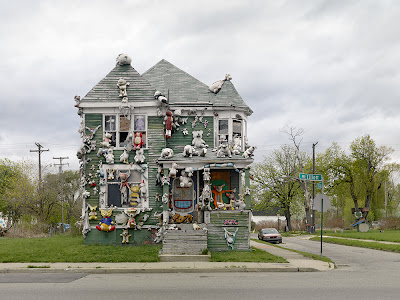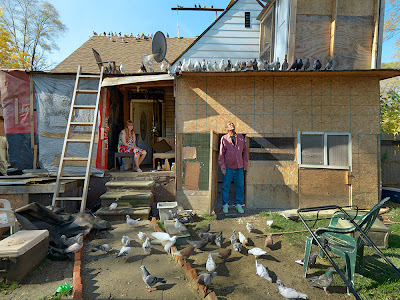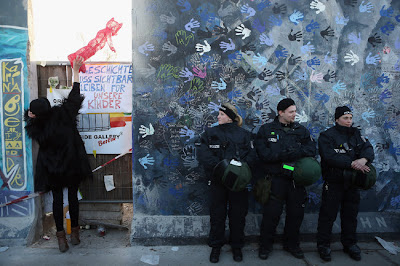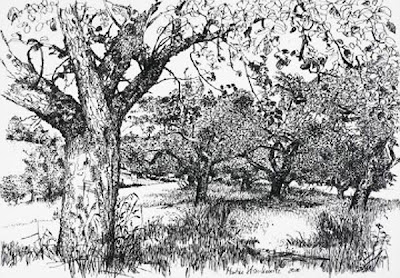Blue Balloon church. A digital manipulation on Josef Svoboda´s set design. By Myriam Mahiques
Since I bought my simple e-reader, the first book I´ve downloaded from my computer is The Illustrated Man, by Ray Bradbury. I am so happy to go back to the great stories of the tattooed man, specially because when I read it for the first time, I was fifteen years old, and of course now I see I´ve lost many subtle subjects of interest. Among them, let us remember the story The Fire Balloons. It doesn´t shock us like others, because this is just a tale of Christian evangelization in Mars. Probably I found it boring in my youth.
Today, I am reflecting about father Joseph Peregrine´s goal to find the fire balloons, -supposedly sinner Martians- to convert them. The main question is if they are man or beast.
Once he proves to the other reverends that the round luminous globes of light, have a soul ('Somehow, they saved us. That proves they have souls.'), he decides to build a church in the hills to attract them with a brand new image of Christ:
Father Peregrine drew the round circle in the center of the blackboard.
'This is Christ, the son of the Father.'
He pretended not to hear the other Fathers' sharp intake of breath.
'This is Christ in all his Glory,' he continued.
'It looks like a geometry problem,' observed Father Stone.
'A fortunate comparison, for we deal with symbols here. Christ is no less Christ, you must admit, in being represented by a circle or a square. For centuries the cross has symbolized his love and agony. So this circle will be the Martian Christ. This is how we shall bring Him to Mars.'
The Fathers stirred fretfully and looked at each other.
'You, Brother Mathias, will create, in glass, a replica of this circle, a globe, filled with bright fire. It will stand upon the altar.'
'A cheap magic trick,' muttered Father Stone Father Peregrine went on patiently: 'On the contrary. We are giving them God in an understandable image. If Christ had come to us on Earth as an octopus, would we have accepted him readily?' He spread his hands. 'Was it then a cheap magic trick of the Lord's to bring us Christ through Jesus, in man's shape? After we bless the church we build here and sanctify its altar and this symbol, do you think Christ would refuse to inhabit the shape before us? You know in your hearts He would not refuse.'
Spherical fractal by Myriam Mahiques. To illustrate the idea of Bradbury´s blue light balloons.
There is here this discussion about the symbolism inside a church, a beautiful example of semiotics, the metaphor of the shape. Then, father Peregrine reflects about the location of a church:
'Is it because they are so odd to the eye?' wondered Father Peregrine. 'But what is a shape? Only a cup for the blazing soul that God provides us all. If tomorrow I found that sea lions suddenly possessed free will, intellect, knew when not to sin, knew what life was and tempered justice with mercy and life
with love, then I would build an undersea cathedral. And if the sparrows should, miraculously, with God's will, gain everlasting souls tomorrow, I would freight a church with helium and take after them, for all souls, in any shape, if they have free will and are aware of their sins, will burn in hell unless given their rightful communions.¨
If the priests accept the image of Christ as a balloon, isn´t it a blasphemy? It seems not in father Peregrine´s eyes:
'But that glass globe you wish placed on the altar,' protested Father Stone.
'Consider the Chinese,' replied Father Peregrine imperturbably. 'What sort of Christ do Christian Chinese worship? An oriental Christ, naturally. You've all seen oriental Nativity scenes. How is Christ dressed? In Eastern robes. Where does He walk? In Chinese settings of bamboo and misty mountain and crooked tree.
His eyelids taper, his cheekbones rise. Each country, each race adds something to Our Lord. I am reminded of the Virgin of Guadalupe, to whom all Mexico pays its love. Her skin? Have you noticed the paintings of her? A dark skin, like that of her worshipers. Is this blasphemy? Not at all.¨
Finally, the ¨idea¨ of a church is built, but they need to incorporate elements of their own memories:
¨The church was not a church but an area cleared of rocks, a plateau on one of the low mountains, its soil smoothed and brushed, and an altar established whereon Brother Mathias placed the fiery globe he had constructed.
At the end of six days of work the 'church' was ready.
'What shall we do with this?' Father Stone tapped an iron bell they had brought
along. 'What does a bell mean to them?'
'I imagine I brought it for our own comfort,' admitted Father Peregrine. 'We need a few familiarities. This church seems so little like a church.¨
I won´t be a spoiler telling my readers the end. I´m just wondering if a church, as a building is needed, or if symbols spread in nature would be enough to satisfy our souls.
To illustrate the post, I´ve digitally manipulated an old picture of one of the great theatre sets by Josef Svoboda. The image triggered me the idea of the church designed as a direct symbol of Christ, in this case, as a blue light balloon. 
































.jpg)





























































